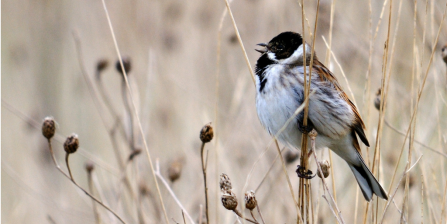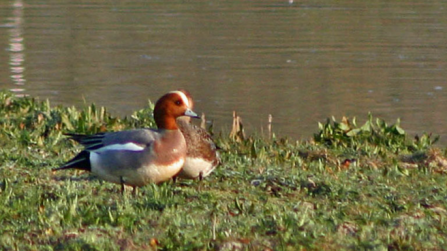
Top 10 riverside wildlife sightings

Curlew
Our largest wading bird has an unmistakable downward-curving bill and thin, gangly legs. Listen out for its haunting ‘cur-lee’ display call from February onwards.
BBOWT’s management of Chimney Meadows nature reserve has created favourable conditions for curlew and other waders.

Corn and reed buntings
Cholsey Marsh is a favoured roosting site for both of these sparrow-sized birds, which are likely to be heard before they’re seen. In winter they join other buntings, finches and sparrows to feed on seed in farmland.
Male corn buntings often perch on top of bushes and may be seen trying out their song – which sounds like a jangling set of keys – on warm days from February.

Little owl
Little owl numbers have fallen steeply over the past decade. Our work in the Upper Thames will help to change the picture locally.
Look out for little owls anywhere they would enjoy a good vantage point – on rocks, branches, telegraph poles or fence posts, for example. If you see one bobbing its head up and down it means it’s alarmed.

Brown hare
The brown hare is a relative newcomer to Britain, having been introduced by the Romans. Open grassland is the best place to watch for this super-fast mammal, especially during the breeding season in early spring when they may be seen fighting or ‘boxing’.

Hobby
Slightly smaller than a kestrel, the hobby is a streamlined falcon that looks somewhat like a large swift. It’s perfectly adapted for hunting out its prey, with superior flying skills combining speed and manoeuvrability. Hobbies hunt everything from dragonflies to house martins.
Look out for them from April when they return from wintering in Africa.

Otter
Otters are natural swimmers; their cubs are in the water from just 10 weeks old! Otters are also ruthlessly efficient predators and will crunch into anything from crustaceans to waterfowl. Swimming in the Thames in winter can be chilly to say the least, but their dense fur keeps them warm.

Kingfisher
What a thrill to spot the electric flash of a kingfisher! Kingfishers fly low over water and keep a lookout for their fish supper from riverside perches like overhanging branches. Their feathers aren’t actually blue – the iridescence is an optical illusion created by the way light reflects from their feathers.

Grey heron
Grey herons have an insatiable appetite for small fish, mammals, amphibians and even small birds. Such is their skill at staying dead-still as they stalk for fish that it’s sometimes difficult to tell whether a heron is real or not. Patience is a virtue, and it seems the heron is a very virtuous bird!

Grass snake
You may not associate snakes with water, but our largest snake loves damp habitats and will lay its eggs among rotting vegetation from June. Grass snakes hibernate during winter but in summer they can be quite active, even taking to the river to cool off on a hot day.

Wigeon
While many British birds migrate south for winter, we also play host to visitors from cold, northern regions such as Iceland, Scandinavia and Russia. The wigeon is one of them.
Wigeons are dabbling ducks but in winter they are more likely to be seen in damp fields next to the river where they ‘graze’ on grass and shoots.
Visit a riverside reserve
Learn more about wildlife at our events
Stay up-to-date with our work
Sign up below to receive the latest news from BBOWT, tips about how you can help wildlife, plus information on how you can get involved.







